|
By Andrew Luck-Baker
BBC Radio 4, Palau
|

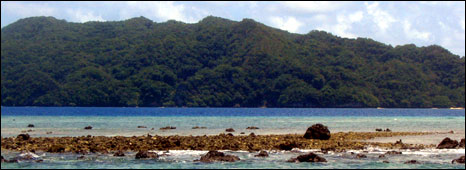
Luke's reef: Reared larvae will come here once they are ready to settle
The coral reefs in the tropical western Pacific are at the brink of
one of the most spectacular and significant nights in their annual life
cycle.
By the light of April's full moon on Sunday or, quite likely a night or two after, corals will be mating en masse.
Along the length of the island archipelago that makes up the Republic
of Palau, millions of coral colonies will simultaneously release
billion upon billion of eggs and sperm into the dark waters.
An hour or so after sunset, each spawning coral will discharge showers of sex cells, packaged in orange and pink blobs.
They will rise to the surface in such huge numbers that they may form oily slicks metres long.
If the sea conditions are right, spawn slicks can coalesce to be large enough to be visible from space.
Depressing need
Once on the surface, the packages burst open, liberating eggs and sperm for fertilisation.
Countless free-swimming coral larvae then develop and three or four
days later, a few will have survived long enough to make it to the sea
bed.
There they attach to a suitable hard surface and develop into single
baby coral polyps. The next generation of corals on the reefs will be
launched.
A team of marine biologists from Australia, Britain and the Philippines
has come to Palau to take advantage of this wonder of nature in the
cause of coral reef restoration.
The scientists are here to investigate the potential of an experimental
technique known as coral seeding - in other words, collecting some of
the spawn from mass mating events and using it to promote the growth of
new corals on reefs in need of rescue.
The reefs around Palau are in good shape but elsewhere throughout the
tropical world, many coral ecosystems are in a parlous state.
Plenty spare
Pollution, over-fishing and coral bleaching events, which are caused by
marine heat waves, have reduced the amount of coral to the point where
these naturally bio-diverse habitats are at varying degrees of
degradation.
Many are nearing ecological collapse - some have gone forever, already.
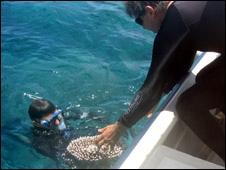
Acropora is an important reef-builder and is common here
|
However, many reefs might be salvageable if they are first protected
from pollution and overexploitation, and then are seeded with some
surplus spawn from more vibrant reefs.
Most of the eggs and larvae from a mass spawning event are eaten or die
before they get an anchor hold on the sea bed, so there is plenty of
spawn to share around.
In the coming experiment on Palau, the scientists will not be using coral spawn produced on the open reefs.
Partly for practical reasons, they will harvest their spawn
under more controllable conditions at the laboratory of the Palau
International Coral Reef Center.
In the lab
On Saturday, I joined them on a trip to collect 10
dinner-plate-sized coral colonies from Luke's reef about 20 minutes
speed-boat-ride from the Reef
Center.
James Guest, from the University of Newcastle, UK, and Maria Vanessa
Baria from the University of the Philippines dived to the sea bed,
armed with hammers and chisels.
They were after a particular species of branching coral which forms
large tables or shelves as it grows. It is this type which is one of
the most abundant and most important reef builders.
It takes a few taps at the stony stalk base of each colony to
break them free. Waiting on the boat to receive the corals was Andrew
Heyward of the Australian Institute for Marine Science - one of the
first biologists to describe the phenomenon of coral mass spawning in
the 1980s.
The colonies were put straight into tubs of sea water, and once the
tenth was on board, we headed back at a high rate of knots to the Reef
Center.
Back at the Center, the coral were transferred with speed to larger tanks, filled with constantly refreshed seawater.
Setting up home
Now there's a lull before the spawn. The main event could happen Sunday
or Monday or Tuesday night (Palau time). And some species will
synchronously spawn the day after others.
When the captive corals in the lab release their eggs and sperm, the
contained spawn will be transferred to children's paddling pools
floating in the sea next to the lab.
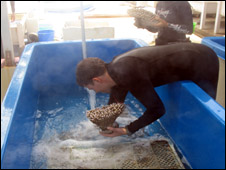
The spawning for these corals will occur in laboratory tanks
|
Over the following few days, the researchers will check the developing
larvae to see how many are mature enough to settle down and become
fixed baby coral polyps.
When sufficient numbers are good to go, the team will take the batch of
larvae back to the reef and pump them over areas of potential
colonisation.
The new homes for the larvae are artificial reef balls placed
there specially for the purpose. They are domes of limestone concrete
about a one metre wide and high.
Before the larva can be introduced, the reef balls will have to be covered so the larvae don't just float away.
Big question
So the team will dive the five metres to the sea bed and erect two-man
camping tents made of fine mesh over each artificial reef structure.
The baby corals will travel from the boat through the zipped door of
the tent via a hose pipe. Andrew Heyward says the aim of this
experiment is to be "low tech or no tech".
He feels this approach is vital if the technique of coral seeding is ever to be used on any scale in developing countries.
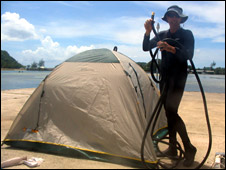
The approach has to be low-tech to succeed, the scientists believe
|
Twenty-four-hours later, the team will check to see how
many of their "seeds" have settled by removing small tiles they've
placed on the reef balls. They will do that again in a few months and
after a year.
Each time they will compare the number of young corals with those on
tiles from control balls which would have been settled by larvae born
in the mass spawning on the reef.
Andrew Heyward points out that loading the dice in the larvae's
favour before they settle is only part of the issue over whether coral
seeding will work to restore reefs.
"If you boost the number of larval corals settling on a coral
reef, so what? Does it make any difference to the longer term compared
to an area where you did nothing?"
The answer will emerge in the next 12 months following this week's frenzy of mass reproduction on the reefs of Palau.
Andrew Luck-Baker is preparing a Frontiers programme to be broadcast on BBC Radio 4 on Monday 26 May
|


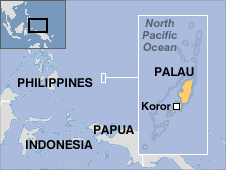






Bookmark with:
What are these?